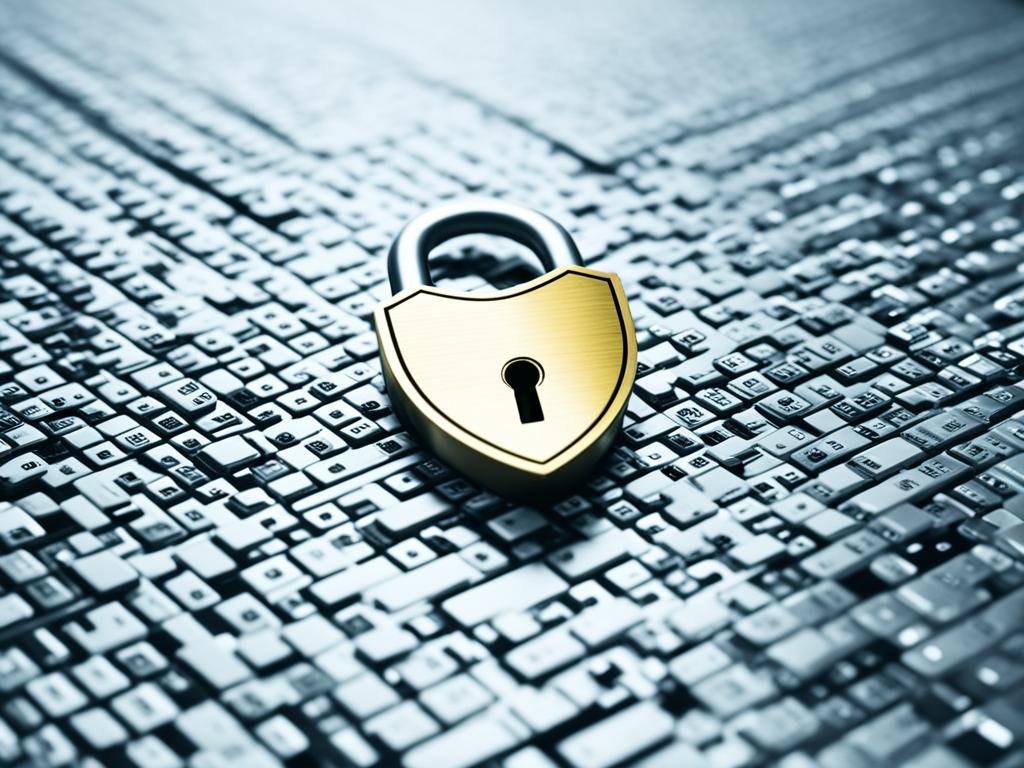In today’s world, keeping your personal and sensitive data safe is more important than ever. Cybercriminals are getting smarter, and there are many dangers online. These include viruses, scams, and tricks to get your information. So, how can you protect yourself from these threats?
Key Takeaways:
- Understanding the diverse cybersecurity threats in the digital landscape
- Implementing data protection measures such as strong passwords and two-factor authentication
- Securing your network against cyber threats through firewalls and network segmentation
- Proactively preventing data breaches through employee education and encryption
- Staying safe online with vigilance and regular software updates
Understanding Cybersecurity Threats

In today’s world, we all face digital threats. These risks can harm our private information and cause problems online. Knowing the kinds of cyber threats helps us stay safe.
Malware is a big threat. It’s short for malicious software. This software is made to hurt or take over computer systems. Examples are viruses, worms, ransomware, and spyware. Malware is often used to steal info, lock up data, or control computers.
Phishing is a serious issue too. It tricks people into giving out private info like passwords or credit card numbers. This trickery often happens through emails or fake websites. Since phishing can look so real, it’s vital to be always careful.
Social engineering uses psychology to get what cybercriminals want. They might act like someone you know or trust to get your info. Their goal is to get you to share private details or do certain things. This includes pretending to be someone they’re not, making up stories, or using bait.
Knowing about these threats and being proactive is key. It helps to keep your online stuff safe.
Examples of Cybersecurity Threats:
| Type of Cyber Threat | Description |
|---|---|
| Malware | Malicious software designed to harm computer systems, steal data, or gain unauthorized access. |
| Phishing Attacks | Deceptive attempts to obtain sensitive information by impersonating legitimate sources. |
| Social Engineering | Psychological manipulation to trick individuals into revealing confidential data or performing actions. |
To keep your data safe, understanding cybersecurity threats is crucial. Stay alert, use strong security, and learn about new threats. This way, both people and companies can avoid cyber attacks.
Data Protection Measures
Protecting your data online is a key task today. It’s crucial to use strong strategies to keep it safe. We’ll look at different ways to make your data more secure. This will help keep your important information private and intact.
Strong Passwords
Using strong, unique passwords is a first and vital step. Make sure your passwords are tough to crack. Include a mix of capital and lowercase letters, numbers, and special symbols. Don’t use personal info like names or birthdays. And think about using a password manager to handle these complex passwords.
Two-Factor Authentication
Adding two-factor authentication (2FA) boosts your online security. It makes you enter a code from your phone, not just your password. This way, even if someone knows your password, they can’t get in. It’s a powerful extra step to protect your accounts.
Regular Data Backups
Always back up your data to stay safe from cyber attacks or hardware issues. Copy your important files to an external drive, cloud, or a NAS device. Set up a backup routine to keep your files current. This way, you’ll fight off unexpected data loss.
“Using strong passwords, implementing two-factor authentication, and regular data backups are integral steps in protecting your valuable data from unauthorized access and potential loss.”
By sticking to these strategies, you make your internet life safer. But remember, cyber-criminals are always coming up with new ways to attack. Stay sharp by learning about the latest in cyber security.
Next, let’s improve your network security and learn good cyber defense. These measures will help make your online world safer against new threats.
Securing Your Network
It’s key to protect your digital assets from online threats. This means using strong cyber defense and safety measures. One important part is making sure your network is safe from online risks.
It’s vital to have strong network security to keep your data safe. The right defense strategies cut down on cyber attacks. This keeps your network safe and working well.
Using Firewalls
Firewalls are your first line against intrusions. They check data going in and out of your network. This lets them only allow the good stuff.
There are two types of firewalls: software and hardware. They help keep bad actors out and protect your network from many threats.
Implementing Network Segmentation
Network segmentation means breaking your network into parts. Each part is on its own, helping stop attacks from spreading.
It’s about putting your most important stuff in separate areas. If one area gets attacked, the rest of your network stays safe.
Monitoring Network Traffic
Watching your network traffic is a must. Tools help you spot anything not right in real time. This lets you act fast to stop threats.
Network traffic is watched by tools that look at the data going by. This way, you can spot and stop threats early on. Constant monitoring is key to a secure network.
Securing your network is critical for keeping cyber threats away. Using firewalls, segmentation, and watching network traffic closely can boost your digital safety. This helps protect your data and keeps your network safe from online risks.
Prevention of Data Breaches
In today’s digital world, stopping data breaches is key. Cyber defense strategies are crucial for online safety. With proactive steps, people and businesses can lower the chances of data leaks. They can keep important info secure.
Employee Education
Teaching staff about online safety is very effective. Organizations should offer detailed training. This helps employees spot and deal with cyber dangers. They learn about threats like phishing and the need for strong passwords.
Vulnerability Scanning
Regularly scanning for security weak points is vital. This helps organizations find and fix issues before attackers strike. They can update their systems and plug the leaks. This keeps their online space safer.
Encryption
Using strong encryption is a must for protecting data. Encryption makes data unreadable without the right keys. By encrypting data whenever it’s stored or moved, safety is improved. This step is key in keeping data breaches from causing major harm.
Regular Audits and Monitoring
Keeping an eye on network traffic is a big help. It lets you catch unusual activities early. This means you can act fast to stop a breach. Regular checks on security also find places that need improvement.
Employee Access Control
Controlling who can see what data is essential. Setting up strict access rules is a good idea. It ensures staff can only use what they really need for their jobs. This cuts down on risks from inside the organization.
To prevent data breaches, taking the lead is necessary. Steps like educating employees and scanning for weaknesses matter a lot. So does using strong encryption, checking things often, and controlling who has access. Following these guidelines boosts online safety for everyone.
Staying Safe Online
In today’s world, staying safe on the internet is very important. You have to protect your information from online risks. Here are some tips to stay safe:
- Watch out for emails that seem off. Cybercriminals often use phishing to get your info. Don’t click on links or open attachments from emails you don’t know.
- If you don’t know where a link goes, don’t click it. Hover over a link to see its true web address. Be careful with messages that include shortened URLs.
- Always keep your software up to date. This includes your operating system and any security software. Updates help protect your devices from new threats.
- Make sure your passwords are strong and different for every account. A good password uses letters, numbers, and symbols. This keeps your accounts safe from hackers.
- Turn on two-factor authentication where you can. This extra step, which might include a text message code, makes your accounts more secure.
- Be careful on public Wi-Fi. Hackers can use these networks to access your personal info. Only use public Wi-Fi safely, like with a VPN, for important things.
- Back up your data regularly. Having copies of your important files prevents data loss. Always keep your backups secure, either on an external drive or in the cloud.
Following these steps and keeping up with online threats will help protect your data. It lowers the risk of online attacks.
“Online safety requires constant vigilance and proactive measures. Protecting your data is not a one-time task but an ongoing commitment to staying informed and implementing best practices.” – Cybersecurity Expert
Ensuring Online Safety for Children
It’s critical to not only protect your data but your children online. Here’s what you can do to keep them safe:
- Set up filters that fit your child’s age on all devices and browsers.
- Talk with them about how to be safe online and set rules for internet use.
- Keep communication open about what they do online.
- Watch over their social media and internet activities.
- Show them how to protect their privacy and avoid sharing personal details.
Online Safety Resources and Tools
To increase your online safety, try these tools:
- Security software: Have good antivirus and anti-malware on your devices.
- Password managers: These keep your passwords strong and safe.
- Virtual Private Network (VPN): A VPN makes your web browsing more secure.
Remember, online safety is everyone’s job. Take steps to safeguard yourself, your data, and your family from online dangers.
| Online Safety Dos | Online Safety Don’ts |
|---|---|
| Regularly update software and devices. | Click on suspicious links or download files from untrusted sources. |
| Enable two-factor authentication for your accounts. | Share personal information on unsecured websites. |
| Use strong and unique passwords. | Use public Wi-Fi networks for sensitive transactions without a VPN. |
| Be cautious about sharing personal information on social media. | Open emails or attachments from unknown senders. |
| Monitor your online presence regularly. | Leave devices unattended or unlocked in public places. |
Responding to Cyber Attacks
Being ready for cyber attacks is key to keep your data safe. It’s important to have a plan for when these incidents happen. This plan guides you on what to do, making your response quick and coordinated.
Incident Response Planning
Identifying who will deal with cyber threats is vital. Assigning roles, setting up communication paths, and a clear chain of command are important. With a solid plan, you can react effectively and reduce harm.
It’s critical to cut off attackers by disconnecting hacked systems. This helps stop the attack from spreading further. Make sure your network is properly divided to contain any breaches.
Post-Incident Analysis
After an attack, figuring out what went wrong is necessary to prevent another one. Analyzing how the attack happened, finding gaps, and checking your response help you get better at defending against future threats.
“Responding to a cyber attack requires a well-coordinated effort and a clear understanding of the incident response plan. The ability to isolate compromised systems and conduct post-incident analysis is crucial to prevent further damage and strengthen our defenses.”
Sometimes, you need outside experts and law enforcement to help after an attack. Working with them and sharing info with other cybersecurity pros is key. This teamwork improves investigations and helps catch the bad guys.
| Key Steps in Responding to Cyber Attacks: |
|---|
| 1. Activate your incident response plan promptly, with designated roles and responsibilities |
| 2. Isolate compromised systems to prevent further damage |
| 3. Collaborate with internal teams, external experts, and law enforcement if necessary |
| 4. Conduct a thorough post-incident analysis to identify vulnerabilities and strengthen defenses |
| 5. Share information and collaborate with the wider cybersecurity community |
By knowing what to do and working with experts, you can react well to cyber threats. This helps keep your data and operations safe in a digital world full of challenges.
Conclusion
In today’s world, keeping our data safe is more important than ever. Cybersecurity threats like malware and phishing attacks are big risks. We must protect our digital lives against these dangers.
It’s vital to keep our valuable data safe. This means using strong passwords and adding layers of security. Backing up your data regularly can also help lessen the impact of cyber threats.
Secure networks are our first line of defense. Firewalls, network segmentation, and consistent monitoring help keep bad actors out. These measures create a safer online space.
Cybersecurity is an ever-changing concern. To stay secure, we must be alert and follow safety tips. Always be careful with emails and links, and keep your software updated to stay ahead of cyber risks.
If an attack happens, quick and smart action is key. Prepare with an incident response plan. Isolate any damaged systems, and analyze what went wrong to prevent future attacks.
To sum up, the risks to our online safety are always present. Everyone, from individuals to big companies, should make data protection a priority. With the right knowledge and actions, we can keep our information safe in the digital world.




